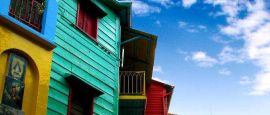This colourful barrio (neighbourhood) is renowned for its football team, Boca Juniors, who play passionately at the local stadium of La Bombonera. Multi-coloured, corrugated-iron houses characterise the main street of Calle Caminito that bustles with street performers, artists and tango dancers. The simple houses were built by Italian immigrants, said to have decorated them with stolen paint from the nearby docks where they worked.
Things to see in Buenos Aires
Tourist offices
Address: Avenida Quintana 596, Recoleta, Buenos Aires, Argentina
Tel: +54 11 4806 0904
Opening Hours:
0900-2000
www.turismo.buenosaires.gob.arThere are several tourist information centres dotted across the city, offering travel advice and other services such as free Wi-Fi, phone charging and water refills. Recoleta’s office is good for local information, while the main Ministry of Tourism Office (Avenida Santa Fe 883) is best for travel beyond Buenos Aires. The tourist centre also runs free English-language guided walks focussing on a different district each day.
In an ultra-modern building, this outstanding museum showcases the best of Latin American art spanning from the 20th century until today. Highlights include works by Argentine artist Antonio Berni and Mexican portraitist Frida Kahlo. The museum also hosts exciting temporary exhibitions, art-house films, talks and lectures and has an onsite gift shop, library and a smart café.
Occupying a grand neoclassical building, the National Fine Arts Museum contains an impressive display of international and Argentine artwork, paintings and sculptures. Collections span from the Middle Ages to the 20th century, with galleries devoted to Impressionists including Renoir, Monet and Degas, and contemporary masterpieces by the likes of Rubens, Rothko and Pollock.
This pigeon-pecked plaza was the scene of the May Revolution of 1810 that led to Argentina’s independence. Its focal point is the dusty-pink Casa Rosada featuring the famous balcony from where prominent figures, ranging from Evita to Diego Maradona, have addressed the crowds. Every Thursday, the mothers of those who disappeared during Argentina’s military dictatorship march around the plaza.
Broken-down beauty is the essence of San Telmo. As one of Buenos Aires’s oldest neighbourhoods, its cobbled streets are flanked by crumbling buildings occupied by atmospheric cafés, bookshops and artist studios. On Sundays, the main thoroughfare becomes an atmospheric outdoor antiques market that spills out onto Plaza Dorrego, a lively square where tango dancers and street musicians perform.
Recoleta’s cemetery is a veritable city of the dead, with countless rows of towering tombs housing the remains of Argentina’s most revered – the most famous being the country’s infamous First Lady, Eva Perón. Founded in 1822, the cemetery also contains tombs, crypts and impressive statues of revered writers, national heroes and former presidents built in various architectural styles. Guided tours are available on site.
The city’s youngest barrio is Puerto Madero, an ambitious regeneration project that has turned a former working dock into a lively waterfront attraction perfect for a weekend stroll. Its red-brick warehouses are now home to galleries, upmarket bars and restaurants. Old cranes line either side of the dock, which is spanned by the Puente de la Mujer (Woman’s Bridge).
The Jardín Japonés in Palermo Park makes the perfect antidote to the hustle and bustle of the city. Created in 1967 as a gift from the local Japanese community, the garden is a tranquil park of Asiatic shrubs and trees beautifully landscaped around a small lake bubbling with huge carp. There’s also an on-site Japanese restaurant that’s worth a stop for lunch.
Inaugurated on the 50th anniversary of Evita's death (26 July 2002), this intriguing museum tells the life story of Eva Perón, who served as the First Lady of Argentina from 1946 until her abrupt death in 1952. The controversial heroine is immortalised through moving personal artefacts including pristine dresses, historic photographs and compelling audiovisual displays.
Built on marshland reclaimed from the River Plate, this 360-hectare (890-acre) ecological reserve has become a verdant park packed with plants and creatures typical of the region. Paths for walkers and cyclists (bikes are for hire at the entrance) crisscross the park where there are many viewing platforms from where to spot hundreds of species of birds.
Do you have any Feedback about this page?
© 2025 Columbus Travel Media Ltd. All rights reserved. No part of this site may be reproduced without our written permission, click here for information on Columbus Content Solutions.








 You know where
You know where